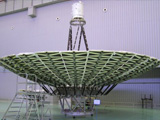|
|
TODAY.AZ / Weird / Interesting
Russian space telescope lifts off, will be biggest telescope ever
19 July 2011 [13:00] - TODAY.AZ
 A new Russian space telescope that will work in concert with radio telescopes on the ground launched earlier today, capping an effort that germinated during the Cold War. It will be the biggest telescope ever, with an effective antenna size spanning 30 times the diameter of the Earth.
A new Russian space telescope that will work in concert with radio telescopes on the ground launched earlier today, capping an effort that germinated during the Cold War. It will be the biggest telescope ever, with an effective antenna size spanning 30 times the diameter of the Earth.The RadioAstron telescope has a 10-meter antenna, a tenth of the size of the biggest radio telescopes on Earth, but when combined with ground-based observatories it will be huge — with a resolution up to 10,000 times better than the Hubble Space Telescope.
Interferometry is widely used to create huge telescope arrays on Earth, connecting individual observatories into a larger network with a much higher effective resolution. RadioAstron is not even the first space-based telescope for interferometry — about 15 years ago the Japanese space agency launched the Highly Advanced Laboratory for Communications and Astronomy (HALCA). But HALCA was only designed to last a few years, and fell silent in 2005. And RadiAstron, also known as Spektr-R, will be 10 times more sensitive than HALCA.
The telescope is designed to unfurl in orbit, with 27 carbon fiber petals unfolding to form a 10-meter-wide dish.
It will have a highly elliptical orbit, allowing the moon’s gravitational pull to shift its path. This highly variable orbital route, along with more powerful computers on the ground, will allow Russian scientists to develop high-resolution images of distant galaxies, according to a report by the South African press agency.
RadioAstron will be able to resolve celestial objects separated by an angle of 7 microarcseconds, which is 10,000 times the resolution of the Hubble Space Telescope, New Scientist notes. Scientists hope it will be able to peer at the event horizon of a black hole at the center of the galaxy M87; study radio waves emitted by water masers, which are clouds of water molecules found in galaxy discs; and study pulsars, among other missions.
But first Roscosmos will have to collect all the telescope’s data, New Scientist says. So far only one dish has been built to receive signals from the spacecraft, and others will be needed so the telescope’s 144 megabits per second of data is not lost.
/Popular Science/
URL: http://www.today.az/news/interesting/90784.html
 Print version
Print version
Views: 1930
Connect with us. Get latest news and updates.
See Also
- 06 December 2024 [22:20]
Are scented candles harmful to health? - 23 November 2024 [14:11]
Magnitude 4.5 earthquake hits Azerbaijan's Lachin - 20 November 2024 [23:30]
Launch vehicle with prototype of Starship made its sixth test flight - 27 October 2024 [09:00]
Fuel prices expected to rise in Sweden - 24 October 2024 [19:14]
Turkiye strikes terror targets in Iraq and Syria - 23 October 2024 [23:46]
Kazakhstan supplied almost entire volume of oil planned for 2024 to Germany in 9 months - 23 October 2024 [22:17]
Taiwan reported passage of Chinese Navy aircraft carrier near island - 23 October 2024 [21:50]
Russia remains largest oil supplier to India - 16 October 2024 [17:54]
Gamesummit co-founder shares insights on future of gaming industry in Azerbaijan [EXCLUSIVE] - 12 October 2024 [18:27]
TikTok cuts jobs, turns to AI for content moderation
Most Popular
 Azerbaijan, Colombia Discuss Cooperation in Various Fields
Azerbaijan, Colombia Discuss Cooperation in Various Fields
 Armenian militant group threatens regional stability aligning with PKK/YPG in new ground
Armenian militant group threatens regional stability aligning with PKK/YPG in new ground
 Azerbaijan and Qatar strengthen environmental cooperation, says Minister
Azerbaijan and Qatar strengthen environmental cooperation, says Minister
 Armenian History in Crisis: Mirzoyan, Textbook and Colosseum
Armenian History in Crisis: Mirzoyan, Textbook and Colosseum
 Azerbaijani delegation attends "Vietnam Defence Expo 2024" in Hanoi
Azerbaijani delegation attends "Vietnam Defence Expo 2024" in Hanoi
 West has no interest in him: the United States has disowned Vardanyan
West has no interest in him: the United States has disowned Vardanyan
 Azerbaijani and Turkish parliament speakers meet in Ankara
Azerbaijani and Turkish parliament speakers meet in Ankara
